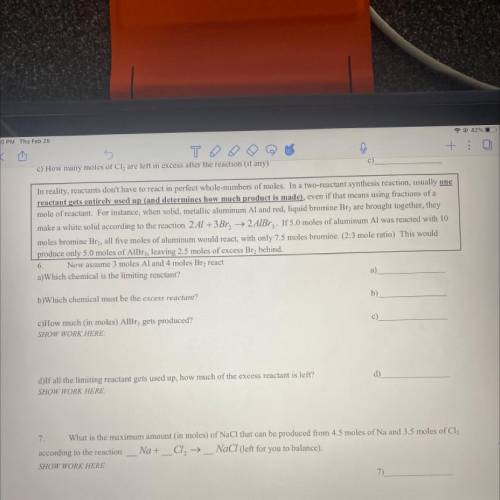
Chemistry, 26.02.2021 02:10 ruffnekswife
In reality, reactants don't have to react in perfect whole-numbers of moles. In a two-reactant synthesis reaction, usually one
reactant gets entirely used up (and determines how much product is made), even if that means using fractions of a
mole of reactant. For instance, when solid, metallic aluminum Al and red, liquid bromine Bry are brought together, they
make a white solid according to the reaction 2. Al + 3 Br, → 2 AIBr, If 5.0 moles of aluminum Al was reacted with 10
moles bromine Bry, all five moles of aluminum would react, with only 7.5 moles bromine. (2:3 mole ratio) This would
produce only 5.0 moles of AIBr;, leaving 2.5 moles of excess Br, behind.
6. Now assume 3 moles Al and 4 moles Br2 react
a)Which chemical is the limiting reactant?
b)Which chemical must be the excess reactant?
b)
c)
c)How much (in moles) AIBr; gets produced?
SHOW WORK HERE:
d)
d)If all the limiting reactant gets used up, how much of the excess reactant is left?
SHOW WORK HERE:
<
7. What is the maximum amount (in moles) of NaCl that can be produced from 4.5 moles of Na and 3.5 moles of Cl2
according to the reaction Na +_ Cl, → _NaCl (left for you to balance).
SHOW WORK HERE:
7).
3
3


Answers: 1
Another question on Chemistry

Chemistry, 22.06.2019 14:00
In the space, show a correct numerical setup for calculating the number of moles of co2 present in 11 grams of co2
Answers: 1

Chemistry, 22.06.2019 21:30
How many liters of 3.0 m naoh solution will react with 0.60 liters of 4.0 m h2so4? h2so4 + naoh → na2so4 + h2o 1.2 l 1.6 l 2.4 l 2.8 l
Answers: 3

Chemistry, 23.06.2019 02:00
Scientists are often interested in knowing the molar heat of combustion – the heat released during the combustion of one mole of a substance. use the periodic table to find molar masses. how many moles of ethanol are present in the sample?
Answers: 2

Chemistry, 23.06.2019 04:31
Areaction is first order. if the initial reactant concentration is 0.0200 m, and 25.0 days later the concentration is 6.25 x 10-4 m, then its half-life is:
Answers: 1
You know the right answer?
In reality, reactants don't have to react in perfect whole-numbers of moles. In a two-reactant synth...
Questions

Chemistry, 20.03.2020 10:09



Mathematics, 20.03.2020 10:09



Chemistry, 20.03.2020 10:09



Computers and Technology, 20.03.2020 10:09



Mathematics, 20.03.2020 10:09


Mathematics, 20.03.2020 10:09




Mathematics, 20.03.2020 10:09

Mathematics, 20.03.2020 10:09



